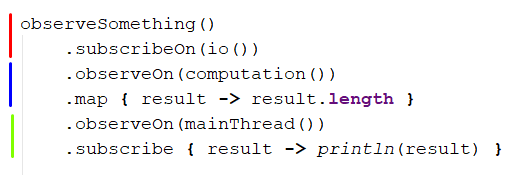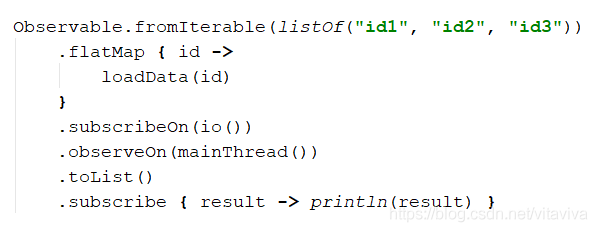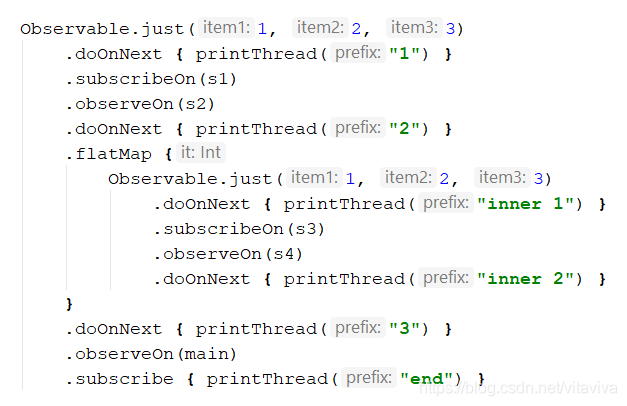线程切换哪家强?RxJava与Flow的操作符对比
作者:fundroid
链接:https://juejin.cn/post/6943037393893064734#heading-13

Flow作为Coroutine版的RxJava,同RxJava一样可以方便地进行线程切换。本文针对两者在多线程场景中的使用区别进行一个简单对比。
1、RxJava
我们先来回顾一下RxJava中的线程切换

如上,RxJava使用subscriberOn与observeOn进行线程切换
1.1 subscribeOn
subscribeOn用来决定在哪个线程进行订阅,对于Cold流来说即决定了数据的发射线程。使用中有两点注意:
当调用链上只有一个subscribeOn时,可以出现在任意位置


上面两种写法效果是一样的:都是在io线程订阅后发射数据
当调用链上有多个subscribeOn时,只有第一个生效:

上面第二个subscribeOn没有意义
1.2 observeOn
observeOn用来决定在哪个线程上响应:
observeOn决定调用链上下游操作符执行的线程

上面绿线部分的代码将会运行在主线程
与subscribeOn不同,调用链上允许存在多个observeOn且每个都有效

上面蓝色绿色部分因为observeOn的存在分别切换到了不同线程执行
1.3 just
RxJava的初学者经常会犯的一个错误是在Observable.just(...)里做耗时任务。just并不是接受lambda,所以是立即执行的,不受subscribeOn的影响

如上,loadDataSync()不会在io执行,
想要在io执行,需要使用Observable.deffer{}

1.4 flatMap
结合上面介绍的RxJava的线程切换,看下面这段代码

如果我们希望loadData(id)并发执行,那么上面的写法是错误的。
subscribe(io())意味着其上游的数据在单一线程中串行发射。因此虽然flatMap{}返回多个Observable, 都是都在单一线程中订阅,多个loadData始终运行在同一线程。
代码经过一下修改后,可以达到并发执行的效果:

当订阅flatMap返回的Observable时,通过subscribeOn分别指定订阅线程。
其他类似flatMap这种涉及多个Observable订阅的操作符(例如merge、zip等),需要留意各自的subscribeOn的线程,以防不符合预期的行为出现。
2、Flow
接下来看一下Flow的线程切换 。
Flow是基于CoroutineContext进行线程切换,所以这部分内容需要你对Croutine事先有基本的了解。

flowOn类似于RxJava的subscribeOn,Flow中没有对应observeOn的操作符,因为collect是一个suspend函数,必须在CoroutineScope中执行,所以响应线程是由CoroutineContext决定的。例如你在main中执行collect,那么响应线程就是Dispatcher.Main
2.1 flowOn
说flowOn类似于subscribeOn,因为它们都可以用来决定上游线程

上面代码中,flowOn前面代码将会在IO执行。
与subscribeOn不同的是,flowOn允许出现多次,每个都会影响其前面的操作

上面代码,根据颜色可以看出来flowOn影响的范围
2.2 launchIn
collect是suspend函数,所以后续代码因为协程挂起不会继续执行

所以上面代码可能会不符合预期,因为第一个collect不走完第二个走不到。
正确的写法是为每个collect单独起一个协程

或者使用launchIn,写法更加优雅

launchIn不会挂起协程,所以与RxJava的subscribe更加接近。
通过名字可以感觉出来launchIn只不过是之前例子中launch的一个链式调用的语法糖。
2.3 flowOf
flowOf类似于Observable.just(),需要注意flowOf内的内容是立即执行的,不受flowOn影响

希望calculate()运行在IO,可以使用flow{ }

2.4 flatMapMerge
flatMapMerge类似RxJava的flatMap

如上,2个item各自flatMap成2个item,即一共发射了4条数据,日志输出如下:
inner: pool-2-thread-2 @coroutine#4inner: pool-2-thread-3 @coroutine#5inner: pool-2-thread-3 @coroutine#5inner: pool-2-thread-2 @coroutine#4collect: pool-1-thread-2 @coroutine#2collect: pool-1-thread-2 @coroutine#2collect: pool-1-thread-2 @coroutine#2collect: pool-1-thread-2 @coroutine#2
通过日志我们发现flowOn虽然写在flatMapMerge外面,inner的日志却可以打印在多个线程上(都来自pool2线程池),这与flatMap是不同的,同样场景下flatMap只能运行在线程池的固定线程上。
如果将flowOn写在flatMapMerge内部

结果如下:
inner: pool-2-thread-2 @coroutine#6inner: pool-2-thread-1 @coroutine#7inner: pool-2-thread-2 @coroutine#6inner: pool-2-thread-1 @coroutine#7collect: pool-1-thread-3 @coroutine#2collect: pool-1-thread-3 @coroutine#2collect: pool-1-thread-3 @coroutine#2collect: pool-1-thread-3 @coroutine#2
inner仍然打印在多个线程,flowOn无论写在flatMapMerge内部还是外部,对flatMapMerge内的处理没有区别。
但是flatMapMerge之外还是有区别的,看下面两段代码


通过颜色可以知道flowOn影响的范围,向上追溯到flowOf为止
3、Summary
RxJava的Observable与Coroutine的Flow都支持线程切换,相关API的对比如下:
| 线程池调度 | 线程操作符 | 数据源同步创建 | 异步创建 | 并发执行 | |
|---|---|---|---|---|---|
| RxJava | Schedulers (io(), computation(), mainThread()) | subscribeOn, observeOn | just | deffer{} | flatMap(inner subscribeOn) |
| Flow | Dispatchers (IO, Default, Main) | flowOn | flowOf | flow{} | flatMapMerge(inner or outer flowOn) |
最后通过一个例子看一下如何将代码从RxJava迁移到Flow
3.1 RxJava
RxJava代码如下:

使用到的Schedulers定义如下:

代码执行结果:
1: pool-1-thread-11: pool-1-thread-11: pool-1-thread-12: pool-3-thread-12: pool-3-thread-12: pool-3-thread-1inner 1: pool-4-thread-1inner 1: pool-4-thread-2inner 1: pool-4-thread-1inner 1: pool-4-thread-1inner 1: pool-4-thread-2inner 1: pool-4-thread-2inner 1: pool-4-thread-3inner 2: pool-5-thread-1inner 2: pool-5-thread-23: pool-5-thread-1inner 2: pool-5-thread-2inner 1: pool-4-thread-3inner 2: pool-5-thread-2inner 2: pool-5-thread-33: pool-5-thread-13: pool-5-thread-13: pool-5-thread-1end: pool-6-thread-1end: pool-6-thread-1inner 1: pool-4-thread-3end: pool-6-thread-13: pool-5-thread-1inner 2: pool-5-thread-13: pool-5-thread-1inner 2: pool-5-thread-3inner 2: pool-5-thread-1end: pool-6-thread-13: pool-5-thread-33: pool-5-thread-3end: pool-6-thread-1inner 2: pool-5-thread-33: pool-5-thread-3end: pool-6-thread-1end: pool-6-thread-1end: pool-6-thread-1end: pool-6-thread-1
代码较长,通过颜色标记法帮我们理清线程关系

上色后一目了然了,需要特别注意的是由于flatMap中切换了数据源的同时切换了线程,所以打印3的线程不是s2 而是 s4
3.2 Flow
首相创建对应的Dispatcher

然后将代码换成Flow的写法,主要遵循下列原则
RxJava通过observeOn切换后续代码的线程
Flow通过flowOn切换前置代码的线程

打印结果如下:
1: pool-1-thread-1 @coroutine#61: pool-1-thread-1 @coroutine#61: pool-1-thread-1 @coroutine#62: pool-2-thread-2 @coroutine#52: pool-2-thread-2 @coroutine#52: pool-2-thread-2 @coroutine#5inner 1: pool-3-thread-1 @coroutine#10inner 1: pool-3-thread-2 @coroutine#11inner 1: pool-3-thread-3 @coroutine#12inner 1: pool-3-thread-2 @coroutine#11inner 1: pool-3-thread-3 @coroutine#12inner 2: pool-4-thread-3 @coroutine#9inner 1: pool-3-thread-1 @coroutine#10inner 1: pool-3-thread-3 @coroutine#12inner 1: pool-3-thread-2 @coroutine#11inner 2: pool-4-thread-1 @coroutine#7inner 2: pool-4-thread-2 @coroutine#8inner 2: pool-4-thread-1 @coroutine#7inner 2: pool-4-thread-3 @coroutine#9inner 1: pool-3-thread-1 @coroutine#103: pool-4-thread-1 @coroutine#3inner 2: pool-4-thread-3 @coroutine#9inner 2: pool-4-thread-2 @coroutine#8end: pool-5-thread-1 @coroutine#23: pool-4-thread-1 @coroutine#3inner 2: pool-4-thread-2 @coroutine#83: pool-4-thread-1 @coroutine#3end: pool-5-thread-1 @coroutine#23: pool-4-thread-1 @coroutine#3end: pool-5-thread-1 @coroutine#2end: pool-5-thread-1 @coroutine#23: pool-4-thread-1 @coroutine#33: pool-4-thread-1 @coroutine#3end: pool-5-thread-1 @coroutine#2end: pool-5-thread-1 @coroutine#23: pool-4-thread-1 @coroutine#33: pool-4-thread-1 @coroutine#3end: pool-5-thread-1 @coroutine#2end: pool-5-thread-1 @coroutine#2inner 2: pool-4-thread-1 @coroutine#73: pool-4-thread-1 @coroutine#3end: pool-5-thread-1 @coroutine#2
从日志可以看到,1、2、3的时序性以及inner1和inner2的并发性与RxJava的一致。
4、FIN
Flow在线程切换方面可以完全取代RxJava的能力,而且将subscribeOn和observeOn两个操作符合二为一成flowOn,学习成本更低。随着flow的操作符种类日趋完善,未来在Android/Kotlin开发中可以跟RxJava说再见了👋🏻


